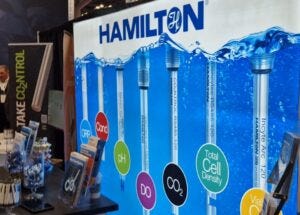Content Spotlight
Podcast: MilliporeSigma says education vital to creating unbreakable chain for sustainability
MilliporeSigma discusses the importance of people, education, and the benefits of embracing discomfort to bolster sustainability efforts.

Date: May 3, 2023
Duration: 20 Min
Hamilton Company showcased inline sensors measuring cell density, carbon dioxide, and other bioprocess variables at this year’s Interphex in New York last week.
Life sciences firm Hamilton sells inline measurement solutions to biomanufacturers aimed at providing inline measurement to improve biomanufacturers’ process understanding and control. Jacob Crowe, manager of Applications and Tech Support, Process Analytics at Hamilton Company, introduced three of these to BioProcess Insider.

“The first is what we call our Incyte Arc. It’s a viable cell density measurement that gives you inline biomass measurements of living cells only within your process,” he said.
“In addition to that one, we released a total cell density sensor [known as Dencytee Arc] based upon optical density to essentially measure in a very straightforward methodology, the total amount of cells within a within a bioprocess.”
According to Crowe, this sensor is suited for fermentation processes where typically there is quick turnaround in growth cycle from inoculation all the way to harvest, giving a clear measurement of inline biomass.
The third sensor was CO₂NTROL, a carbon dioxide measurement system. “The value proposition for this one is it’s essentially a maintenance-free inline measurement of dissolved CO2 to not only get a number and get it continuously but be able to do things like connect it to your mass flow controller or connect it to your head gas overlay to control those dissolved CO2 levels within customer desired measurements specs and be able to do it reproducibly.
“In the mammalian space or the animal cell culture space, cells operate very much within a defined CO2 range under normal metabolic conditions. Too high a CO2 concentration and you essentially are either stunting the metabolic growth, potentially altering pH. In both cases, those things result in reduced growth attributes, which can translate to reduced product quality as well as product quantity.”
View the full video below:
You May Also Like